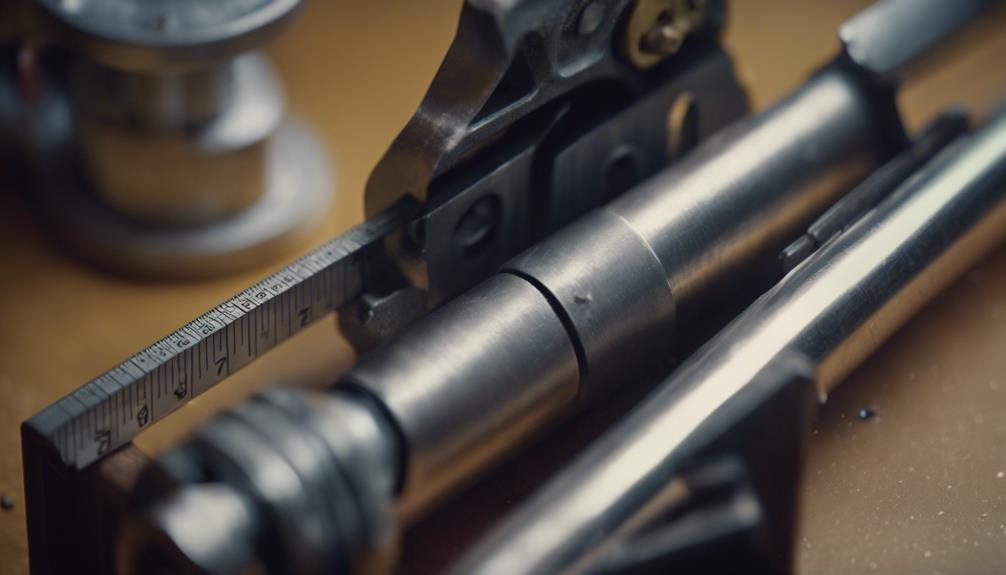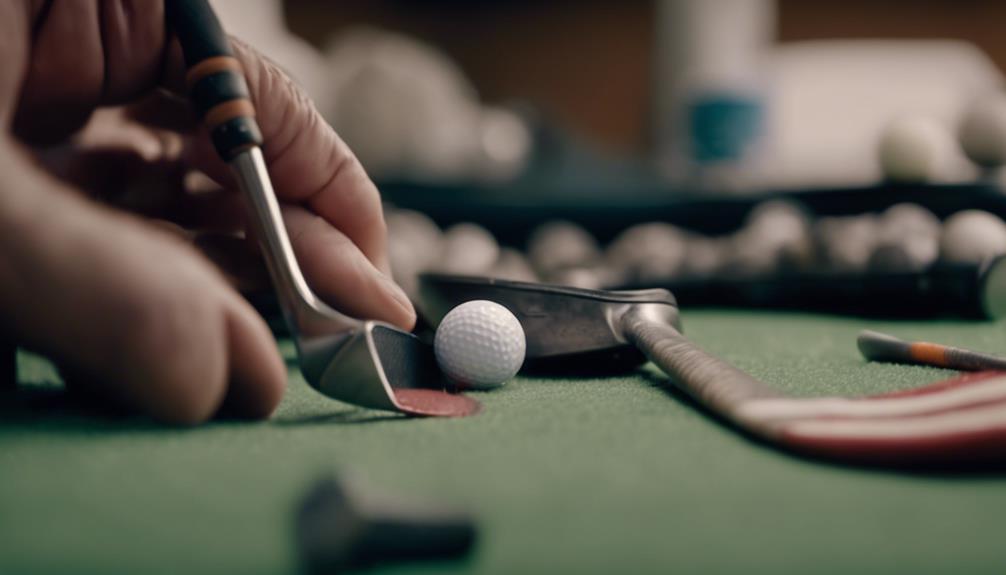- 7 Top Flite Golf Clubs XL for Improved Performance - September 28, 2024
- Top Flite Golf Clubs: Top 5 Reasons to Choose Them - September 28, 2024
- Top 3 Golf Club Fitters for a Perfect Swing - September 28, 2024
To add length to a golf club, you'll need to determine your ideal club length based on your height, arm length, swing style, and club type. Measure the distance from your wrist crease to the floor to find your perfect fit. Choose a shaft extender that matches your shaft material, and prepare the extension by abrading it for a secure epoxy hold. Install the extender, reinstall the grip, and test your club to verify a smooth, consistent swing. By following these steps, you'll be able to optimize your club's length and improve your performance – but there's more to contemplate to get the most out of your extended club.
Key Takeaways
- Measure the distance from the wrist crease to the floor to determine the desired club length, considering factors like height and arm length.
- Choose a shaft extender compatible with the shaft material and abrade it prior to installation for a secure epoxy hold.
- Inspect the area where the extension will be attached, ensuring it's free of dirt, oils, and contaminants for a strong bond.
- Use the right materials for the shaft extension, such as steel or nylon/plastic, and follow the manufacturer's instructions for preparation.
- Reinstall the grip, maintaining proper alignment, and test the club with several swings to confirm a comfortable and secure feel.
Determining Desired Club Length
To determine the ideal length for your golf clubs, you'll need to factor in a combination of elements, including your height, arm length, swing style, and the type of club you're using.
This will help you find your desired club length, which is essential for peak performance.
Generally, golfers with a height of 5'9' or taller may benefit from longer clubs, while those under 5'6' may prefer shorter clubs.
A good starting point for determining your desired club length is to measure the distance from your wrist crease to the floor.
For men, the average length is around 34-35 inches, while for women, it's around 33-34 inches.
Additionally, consider the club's lie angle, as a more upright lie may require a shorter shaft, while a flatter lie may require a longer shaft.
By considering these factors, you'll be able to find the perfect club length that suits your game.
When in doubt, consult with a professional club fitter or take advantage of demo days to try out different club lengths and find what works best for you.
Selecting the Right Shaft Extension
With your desired club length determined, you're now ready to select the right shaft extension to bring your club to its ideal length. This vital step requires attention to detail to strengthen and create a durable bond.
Choose a shaft extender made from the same material as your shaft (e.g., nylon or plastic for graphite shafts, steel for steel shafts).
Abrade the extension pieces prior to installation to create a rough surface for the epoxy to adhere to.
Reuse old shafts as extenders if they're in good condition and compatible with the club being extended.
Epoxy the extension in place to prevent premature failure; avoid using a pressure fit, as this may compromise the bond, and instead solidify it.
Preparing the Shaft for Extension

As you prepare the shaft for extension, carefully inspect the area where the extension will be attached to verify it's free of dirt, oils, and other contaminants that might compromise the epoxy bond.
This is vital to guarantee a strong hold, especially when working with graphite shafts. When using graphite shafts, abrading the extension piece prior to installation is imperative to guarantee a secure epoxy hold.
Remember to follow the manufacturer's instructions for preparing the shaft, and consider consulting a professional fitter or club maker if you're unsure about the process.
When reusing old graphite shafts as extenders, make sure they're in good condition and properly prepared for extension.
Always epoxy the graphite shaft extension in place, rather than relying on pressure fits, to maintain the integrity of the shaft. Keep in mind that graphite shafts shouldn't be extended more than 2 inches, and it's recommended to use nylon or plastic golf club extensions instead of steel extensions to prevent premature failure.
Installing the Shaft Extension
When installing the shaft extension, guarantee a secure bond between the shaft and extension by using steel extenders and epoxy for steel shafts, and nylon or plastic extensions with epoxy for graphite shafts.
A strong hold is achieved by abrading the extension pieces prior to installation, especially for unplated steel extensions, to confirm the epoxy adheres properly and creates a durable bond.
Choose the right materials: Steel extenders and epoxy are essential for extending steel shafts, while nylon or plastic extensions with epoxy are suitable for graphite shafts.
Prepare the extension: Abrade the extension pieces to guarantee a strong epoxy hold.
Avoid pressure fits: A secure bond relies on a strong epoxy hold, not pressure fits.
Consider the club's overall weight and balance: Extending shafts increases swingweight and affects the club's balance point, so make adjustments accordingly.
Reinstalling the Grip and Testing

Now that the shaft extension is securely in place, you'll need to reinstall the grip and test the club to confirm proper performance.
You'll want to pay close attention to grip alignment, verifying it's properly positioned to match your swing style.
Next, you'll re-grip the club and conduct a final swing analysis to guarantee a smooth, consistent swing.
Grip Alignment Check
You'll need to reinstall the grip on your golf club, maintaining it's properly aligned to maintain consistency in your swing.
This grip alignment check is vital to verify the clubface squares up correctly at impact.
To perform the check, follow these steps:
- Hold the club vertically: Hold the club with the grip facing upwards, allowing you to inspect the alignment.
- Check the grip's orientation: Verify that the grip is aligned with the clubface, making sure the grip's pattern or markings are parallel to the face.
- Inspect the clubface: Double-check that the clubface is square to the target line, confirming the club is properly aligned.
- Make adjustments as needed: If the grip is misaligned, make the necessary adjustments to maintain proper alignment.
Re-Gripping the Club
With the grip alignment check complete, reinstall the grip on your golf club by applying a small amount of grip solvent or tape to the shaft, then sliding the grip into place, making certain it's securely fastened to prevent any slippage during play.
When re-gripping a golf club, it's vital to maintain the club's original specifications and performance characteristics. To achieve this, consider using a grip with a similar size, texture, and material to the original grip.
After re-gripping, test the club by swinging it several times to confirm the grip feels comfortable and secure in your hands.
This will help you detect any potential issues with the grip's alignment or installation. You can use a grip gauge or alignment tool to double-check the grip's alignment with the clubface, as even slight misalignments can affect the club's performance and your overall game.
Final Swing Analysis
After reinstalling the grip, take a few practice swings to assess the club's overall feel and performance, paying close attention to any subtle changes in balance, weight distribution, or swing tempo. This is your final swing analysis, where you'll fine-tune your club to achieve ideal results.
As you swing, focus on the following key aspects:
Clubhead speed: Has the added length increased your clubhead speed, resulting in more distance?
Ball flight: Is the ball flying straighter and more consistently, or are you noticing any deviations in trajectory?
Swing tempo: Has the added weight affected your swing tempo, causing you to slow down or speed up?
Overall feel: Does the club feel more balanced and responsive in your hands, or are there any areas that need further adjustment?
Tips for Extending Specific Club Types
When extending specific club types, golfers should consider the unique demands and characteristics of each club, as varying extension methods and considerations apply to different irons, woods, and hybrids. For instance, extending irons requires attention to individual swing characteristics, as a 1/2-inch extension may not address thin shots for all golfers.
| Club Type | Extension Considerations |
|---|---|
| Irons | Consider individual swing characteristics, posture, and back strain. Alternative methods like soft-stepping shafts or using aluminum/plastic extensions may be explored. |
| Woods | Focus on maintaining proper swing speed and tempo, as extensions can affect clubhead speed. |
| Hybrids | Balance extension with clubhead design, as larger heads may require less extension. |
Properly fitting and adjusting the lie angle after extension is essential to maintain performance and avoid negative side effects. Trying extended shafts before committing to a full set is recommended. While extending irons can affect club feel, proper extension and fitting can minimize negative effects on performance. By understanding these nuances, you can optimize your golf club extensions for improved performance and comfort.
Frequently Asked Questions
How Do I Add Half an Inch to a Golf Club?
When you need to add half an inch to a golf club, you'll use a shaft extension, ensuring a strong bond with epoxy, and consider reusing old shafts as extenders, while adjusting the club's lie angle and swing weight accordingly.
How Do I Add Length to a Putter?
When you're adjusting your putter's length, prioritize proper putter fitting by epoxying a nylon or plastic extension to the graphite shaft, ensuring a strong hold, and re-weighting the clubhead or adjusting the grip size to maintain ideal performance.
How Do You Size Golf Clubs for Your Height?
You might think you're too short or too tall for standard clubs, but don't worry, the fitting process guarantees a perfect match; you'll work with a pro to find the ideal length and shaft flex, tailored to your unique height and swing style.
How Do You Determine Your Golf Club Length?
You determine your golf club length by considering your body type, height, and wrist-to-floor measurement, as taller or leaner golfers may require longer clubs, while shorter or stockier golfers may need shorter ones.
Conclusion
Now that you've successfully added length to your golf club, imagine the envy of your playing partners as you tower over them, your extended club resembling a giant sword, ready to vanquish the course.
Your opponents will cower as you initiate a mighty swing, the added length generating unprecedented power and distance.
Okay, maybe not, but at least your drives will be a little longer.




